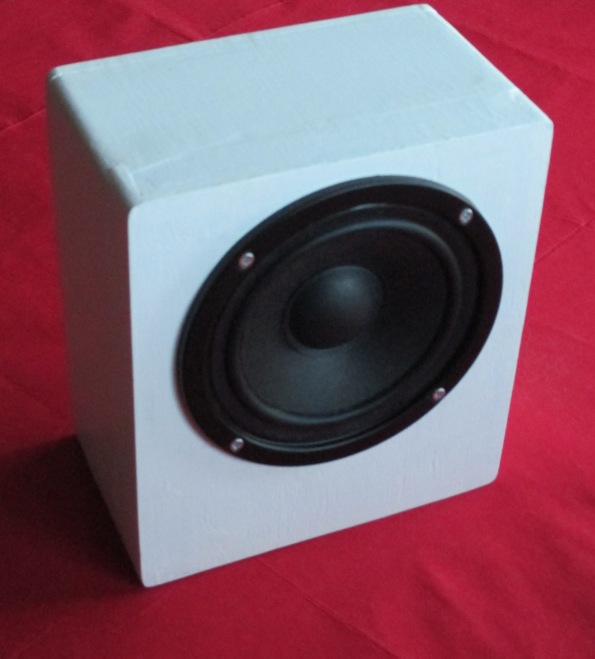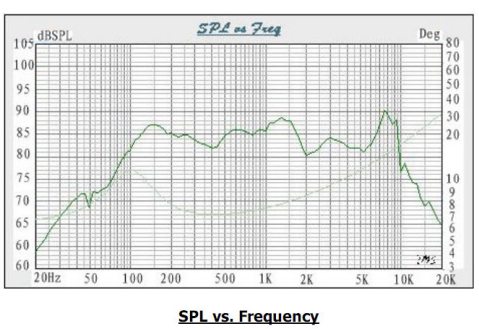The Maks
I am always on the lookout for interesting items that can be used for speaker cabinets. I spotted some sewing boxes in TheWorks
http://www.theworks.co.uk/p/craft-storage/grey-vintage-sewing-box/5052089159334
So for a low cost I had a pair of boxes. When I got them home I realised that the top and bottom panels were too thin for speaker duty, but I had some 6mm birch plywood to hand that could be used to reinforce them. The boxes would be ideal for computer monitors or as rear surround speakers.
What drivers to put in them? I looked around but nothing rocked my boat until I found the 5.25in Maplin driver L69aw. I saw they had been used in Auratone 5C clones. The original Auratones were cubes and pre-date the Yamaha NS10 as a tool for recording engineers to see what their mix sounded like on “ordinary” speakers . I have called the speaker the MAK (minimalist Auratone kit). I have built single driver speakers and was impressed enough with their performance not to be put off by a single driver.
http://amazingdiy.wordpress.com/2012/05/05/davetone-mixcubes/
http://groupdiy.com/index.php?topic=43086.0
http://www.soundonsound.com/sos/sep08/articles/yamahans10.htm
The boxes have almost the same internal volume (2.5litres) as the Auratones so will have approximately the same low end response.
I found the frequency response for the L69AW drive units. This diagram has been removed from the Maplin site so I was suspicious about the actual performance.
I needn’t have worried, when I measured the response it was substantially the same. Now 90Hz to 9.5Khz +/- 5dB for £10 is good value. Listening to the boxed speakers against my Hi-fi reference, the speakers needed some baffle step compensation and a notch filter to get the best results . The small box volume I used limits the bass response to 110Hz and the high frequency limit measured at 9kHz but still impressive especially as the flatness between those limits was +/- 2.5dB with the compensation.
The box front and back panels are made of rather thin wood. To mitigate panel resonances I glued a 6mm plywood sheet to the back panel. I also reinforced the baffle with a 6mm thick 2inch strip internally to damp the portion of the Baffle not occupied by the drive unit. I also used foam draught excluder strip as a gasket for mounting the driver and glued the 2 halves of the boxes together having previously mounted 4mm terminals in the back panel.
The speaker is centred 75mm down from the top edge and the baffle cut-out diameter required is 112mm. I came up with the idea of cutting an overall speaker diameter hole (138mm) in a piece of 4mm plywood and gluing that to the outside of the front panel only after I had built the prototypes. This would give the appearance of a rebated baffle.
The circuit for baffle step and the notch filter is here.
I used Rapid electronics for the parts (double the amounts for a stereo pair)
1 mH 2 off 88-1787
0.47uF 1 off 10-4152
0.1uF 1 off 10-5770
4.7 ohm 3w 2 off 62-0240

I found I needed a notch filter at 6.7kHz since my breakup peaks were at that frequency as opposed to the peak in the diagram at 7.5kHz. However you need some means of checking that the notch filter is at the right frequency since component tolerances could make it slightly off and it is important that the notch frequency matches the breakup peak frequency. For the modest outlay and time involved, I am impressed with the sound of these units.
I had a bit of trouble aligning the lid and box when gluing the Maks. By using corner braces the lid and box can be self aligning. The braces shown are obviously too long for the Maks. They are for a future project. Gluing is a 2 stage operation. The braces are glued to the box, checking the lid will fit, then the lid is glued.

Using a wine box as speaker cabinet:
http://www.hifi-forum.de/viewthread-118-2931.html#14
The box has been out of stock for a while. If you want to make your own, the internal dimensions are 18 X 15.5 X 9cm. I would use 9mm plywood to construct it. Alternatively use the 20 X 25 X 10 box from the same supplier with similar reinforcement.
The Yamaha NS10 has been ctiticised for studio monitoring:



Leave a comment